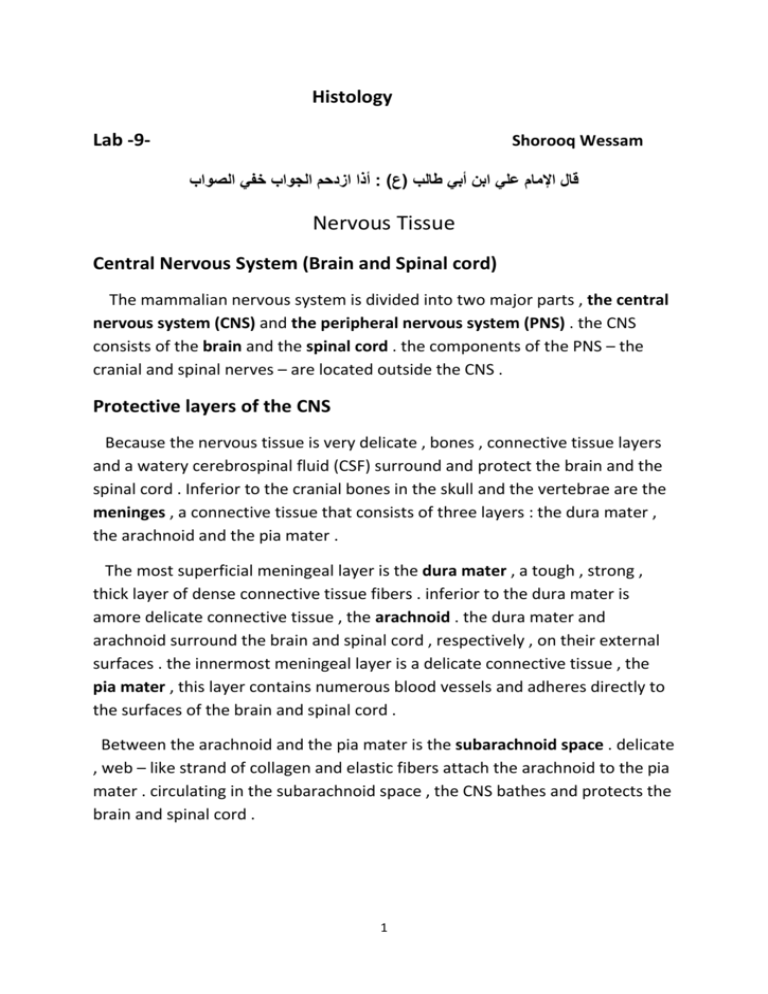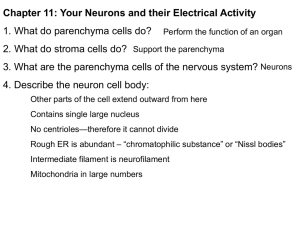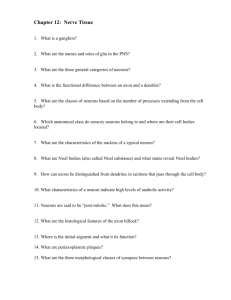Central Nervous System (Brain and Spinal cord)
advertisement

Histology Lab -9- Shorooq Wessam أذا ازدحم الجواب خفي الصواب: )قال اإلمام علي ابن أبي طالب (ع Nervous Tissue Central Nervous System (Brain and Spinal cord) The mammalian nervous system is divided into two major parts , the central nervous system (CNS) and the peripheral nervous system (PNS) . the CNS consists of the brain and the spinal cord . the components of the PNS – the cranial and spinal nerves – are located outside the CNS . Protective layers of the CNS Because the nervous tissue is very delicate , bones , connective tissue layers and a watery cerebrospinal fluid (CSF) surround and protect the brain and the spinal cord . Inferior to the cranial bones in the skull and the vertebrae are the meninges , a connective tissue that consists of three layers : the dura mater , the arachnoid and the pia mater . The most superficial meningeal layer is the dura mater , a tough , strong , thick layer of dense connective tissue fibers . inferior to the dura mater is amore delicate connective tissue , the arachnoid . the dura mater and arachnoid surround the brain and spinal cord , respectively , on their external surfaces . the innermost meningeal layer is a delicate connective tissue , the pia mater , this layer contains numerous blood vessels and adheres directly to the surfaces of the brain and spinal cord . Between the arachnoid and the pia mater is the subarachnoid space . delicate , web – like strand of collagen and elastic fibers attach the arachnoid to the pia mater . circulating in the subarachnoid space , the CNS bathes and protects the brain and spinal cord . 1 Morphology of a typical neuron The structural and functional cells of the nervous tissue are the neurons , each neuron consists of a cell body or perkaryon , numerous dendrits and a single axon . the cell body of the neuron cosists of cytoplasm containing numerous organelles , a nucleus and a nucleolus .projecting from the cell body are numerous cytoplasmic extensions called dendrites that are specialized to receive information from other dendrites , neurons or axon . Axon conduct impulses away from neurons . Neurons from a highly complex intercommunicating network of nerves cells that receive and conduct impulses along their axons to the CNS for analysis , integration , interpretation and response. The appropriate response to a given stimulus from the neurons of the CNS is the activation of muscles (smooth or cardiac) and / or glands (endocrine or exocrine). Types of neurons in the CNS The CNS contains three major types of neurons : multipolar , bipolar and unipolar . this anatomic classification is based on the number of dendrites and axons that originate from the cell body . * Multipolar neurons . these are the most common type in the CNS and they include all motor neurons and iterneurons of the brain and spinal cord . projecting from the cell body of a multipolar neuron are numerous branched dendrites . on the opposite side ofn the opposite side of a multipolar neuron is a single axon. * Bipolar neurons . these are not as common as multipolar neurons and are purely sensory neurons . In bipolar neurons , a single dendrite and a single axon are a single axon are associated with the cell body . bipolar neurons are found in the retina of the eye , in the organ of hearing in the inner ear and in the olfactory epithelium in the upper region of the nose. * Unipolar neurons . most neurons in the adult organism that exhibit only one process leaving the cell body were initially bipolar during embryonic development . the unipolar neurons (formerly called pseudounipolar neurons) are also sensory neurons . unipolar neurons are found in numerous 2 craniosacral ganglia (located in the cranial and sacral regions of the spinal cord) of the body . White and Gray matter The brain and the spinal cord contain both gray matter and white matter . the gray matter of the CNS consistes of neurons , their dendrites and the supportive cells called neuroglia . this region represents the site of synapses between a multitude of neurons and dendrites . the size , shape and mode of branching of these neurons are highly variable , however and depend on which region of the CNS is being examined . White matter in the CNS is devoid of neurons and consists primarily of myelinated axon . the myelin sheath around the axons imparts a white color to this region .(conversely , the lack of myeline imparts a gray color to the gray matter of the CNS) .in addition to myelinated axons , white matter also contains some unmyelinated axons and the supportive neuroglial cells . Dura mater Subdural space Arachnoid Subarachnoid space Pia mater Posterior gray horn Lateral gray horn with motor neurons Central canal Gray matter White matter Anterior gray horn with motor neurons Spinal cord 3









